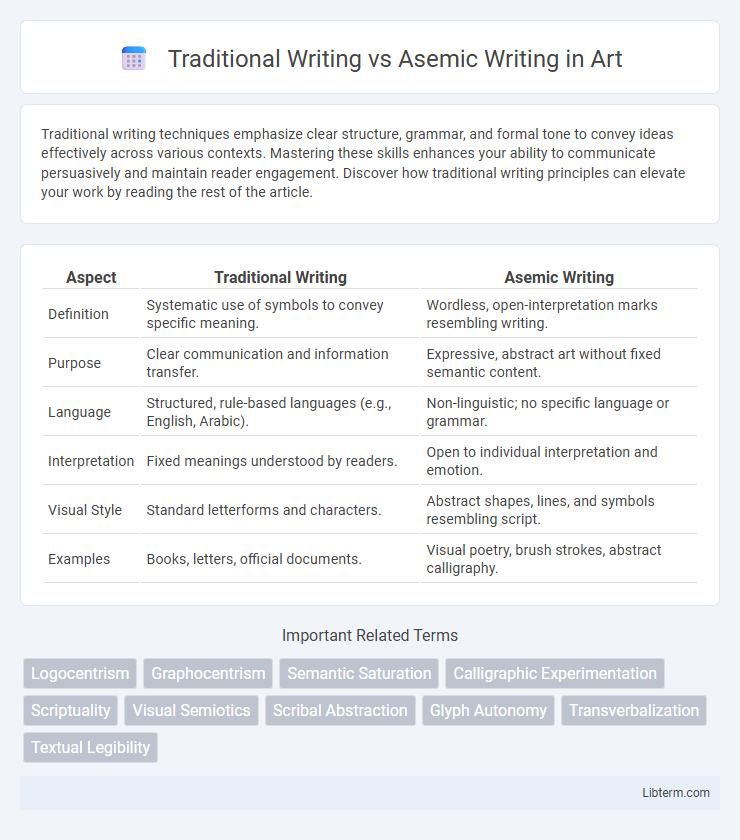Traditional writing techniques emphasize clear structure, grammar, and formal tone to convey ideas effectively across various contexts. Mastering these skills enhances your ability to communicate persuasively and maintain reader engagement. Discover how traditional writing principles can elevate your work by reading the rest of the article.
Table of Comparison
| Aspect | Traditional Writing | Asemic Writing |
|---|---|---|
| Definition | Systematic use of symbols to convey specific meaning. | Wordless, open-interpretation marks resembling writing. |
| Purpose | Clear communication and information transfer. | Expressive, abstract art without fixed semantic content. |
| Language | Structured, rule-based languages (e.g., English, Arabic). | Non-linguistic; no specific language or grammar. |
| Interpretation | Fixed meanings understood by readers. | Open to individual interpretation and emotion. |
| Visual Style | Standard letterforms and characters. | Abstract shapes, lines, and symbols resembling script. |
| Examples | Books, letters, official documents. | Visual poetry, brush strokes, abstract calligraphy. |
Understanding Traditional Writing
Traditional writing consists of structured symbols and characters that convey specific linguistic meanings, allowing clear communication and comprehension across languages and cultures. It follows established grammar, syntax, and semantics, enabling readers to decode messages efficiently and engage with diverse literary forms, including prose, poetry, and academic texts. Mastery of traditional writing is essential for effective information exchange, education, and documentation in various societal contexts.
Defining Asemic Writing
Asemic writing is an abstract, wordless form of expression characterized by marks and symbols that resemble traditional handwriting but lack specific semantic content or linguistic meaning. Unlike traditional writing, which conveys clear messages through recognized alphabets, words, and syntax, asemic writing functions as visual art, emphasizing the aesthetic and emotional resonance of text-like forms without relying on language comprehension. This form challenges conventional reading habits by inviting open interpretation and personal meaning-making through its ambiguous yet evocative strokes and patterns.
Historical Origins of Both Forms
Traditional writing originated around 3200 BCE in Mesopotamia with cuneiform, evolving through Egyptian hieroglyphs and Phoenician alphabets to become the foundation of modern scripts worldwide. Asemic writing emerged much later in the 20th century as a form of abstract, wordless writing, inspired by avant-garde art movements such as Dadaism and Surrealism, rejecting semantic constraints. While traditional writing encodes specific linguistic meaning, asemic writing emphasizes visual form and expressive freedom, reflecting contrasting historical purposes and cultural contexts.
Visual Characteristics Compared
Traditional writing features structured symbols or characters that convey specific linguistic meaning, using consistent shapes and spacing within a defined script such as alphabets or logograms. Asemic writing, by contrast, consists of marks or strokes that resemble text but carry no semantic content, emphasizing abstract visual forms and fluid, often spontaneous line work that invites open interpretation. The visual characteristics of asemic writing highlight texture, rhythm, and composition rather than readability, making it primarily an artistic expression rather than a communicative tool.
Purpose and Intent in Writing
Traditional writing serves to communicate explicit ideas, information, or narratives through structured symbols such as letters and words, aiming for clarity and comprehension. Asemic writing, by contrast, prioritizes visual expression and emotional impact without relying on conventional language, inviting open interpretation and personal meaning. The purpose of traditional writing is to convey definite messages, while asemic writing emphasizes artistic freedom and nonverbal connection.
The Role of Language and Meaning
Traditional writing relies on structured language and syntax to convey explicit meaning, enabling clear communication through established linguistic symbols. Asemic writing, by contrast, eschews conventional language systems and semantic content, focusing on visual expression and abstract forms that invite personal interpretation. The role of language in asemic writing shifts from conveying fixed meaning to evoking emotional or cognitive responses through non-verbal signs and gestures.
Reader Interpretation and Engagement
Traditional writing uses structured language and grammar to convey clear meaning, allowing readers to interpret specific narratives and ideas efficiently. Asemic writing, by contrast, lacks conventional semantic content, inviting readers to engage through personal interpretation and emotional response, fostering a unique, subjective experience. Reader engagement in asemic writing is driven by visual elements and abstract forms, which stimulate imaginative interaction rather than linear comprehension.
Artistic Expression in Writing
Traditional writing uses structured language, grammar, and syntax to convey clear meaning and narrative, serving as a direct form of communication. Asemic writing, free from semantic constraints, prioritizes abstract visual form and emotional resonance, transforming written marks into pure artistic expression. This contrast highlights asemic writing's emphasis on interpretive freedom and aesthetic experience over explicit textual content.
Notable Figures and Examples
Traditional writing features notable figures such as William Shakespeare and Jane Austen, whose works exemplify structured language and semantic clarity. Asemic writing, pioneered by artists like Tim Gaze and e.e. cummings, emphasizes abstract symbols and marks that lack conventional linguistic meaning but evoke interpretive freedom. These contrasting forms highlight the spectrum between representational text and visual expression in written communication.
Future Trends in Written Expression
Traditional writing, characterized by structured alphabets and standardized syntax, remains foundational in communication and education, but future trends indicate a growing influence of asemic writing, which emphasizes abstract, non-semantic symbols that transcend language barriers. Emerging technologies such as augmented reality and neural interfaces are likely to integrate asemic forms, enhancing emotional expression and cognitive engagement beyond the limitations of conventional text. This evolution suggests a hybrid model of written expression that fuses concrete linguistic data with transcendent visual semiosis, fostering new modes of creativity and universal understanding.
Traditional Writing Infographic

 libterm.com
libterm.com